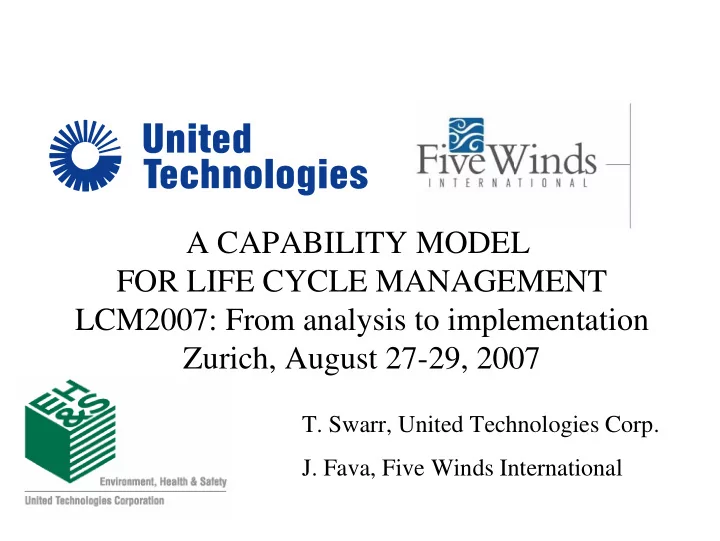

A CAPABILITY MODEL FOR LIFE CYCLE MANAGEMENT LCM2007: From analysis to implementation Zurich, August 27-29, 2007 T. Swarr, United Technologies Corp. J. Fava, Five Winds International
CONFLICTING GOALS Internal decision- making and learning External benchmarking & accountability Customized solutions- product, sector specific International standards, common code of practice 1
Strategy Tomorrow Shape the Future Market based on Driven Sustainability Meet Customer Develop the products and Leadership Reactive requirements services for the market of the 21 st Century Engaged Compliance Engage with value chain and other stakeholders – identify Meet legal opportunities faster requirements Today Source: Five Winds International 2
CAPABILITY MATURITY MODELS Source: A Systems Engineering Capability Maturity Model SM , Version 1.1, Nov. 1995 See also: http://www.sei.cmu.edu/cmmi/general/index.html 3
CMM AND SUSTAINABILITY Description Span of Metrics Decisions Core control Competencies 1 Chaotic, success Individual Compliance, Individual Root cause Ad hoc depends on heroic waste, inci- agenda Aspects & impacts effort of individual dents 2 Requirements man- Project Process in- Team- based, Env. Acctg Managed aged, measured and puts/ outputs visible trade- Risk mgmt repeatable results on offs project basis 3 Standard processes, Organization Gate- to- gate, Rule- based, EMS, LCA, eco- Defined consistent across use phase, trade- offs to efficiency org., measures of regional or achieve org. process & work prod- facility focus goals ucts 4 Statistical process Value Chain Cradle – to- Fact- based, 6 σ , SPC, Quantified control, quantified grave, value anticipate en- LCIA, systems objectives, special chain, global terprise trade- thinking causes of variation impacts offs corrected 5 Process improvement Society Sustainability Value- based, Dynamic modeling Optimizing objectives continually measures, co- evolution & simulation, eco- revised to reflect externalities of business system valuation, within socio- innovation changing business objectives, agile & economic con- innovative workforce text 4
ACTION LEARNING WORKSHOP Accelerated implementation Hosted by business unit Facilitated by LCM champion Feedback from work outcome PLANNING DEFINITION VALIDATION DELIVERY SUPPORT ACTIONABLE TASKS 5
EXPAND PROBLEM BOUNDARY Guard the machine OR Safely make a good part 6
DECISION CRITERIA PRE- DEFINED Ranking of idea selection criteria producibility (incl. Worker Environmentally Friendly cost of ownership (fuel SUM OF SCORES (noise & haz mat) Performance to customer spec Product Safety consumption) maintainable repairable schedule reliable safety) weight cost A B C D E F G H I J K a a a a a a a a a k 10 A A = c b e b g b b b k 6 B B = d e c g c c c k 6 C C = d d d d d d k 8 D D = e e e e E k 8 E E = g h i f k 2 F F = g g g k 7 G G = i h k 3 H K = I k 4 I I = k 1 J J = 11 The selection or prioritization of ultimately best suited solutions depends K K = 1 on the criteria selected, as well as their prioritization or weighting. L = 1 M = 1 Method to use the "Selection Criteria" Table: N = 1 1. Enter the name of each criteria (table only accepts 14 criteria). If less then 14 O = 1 criteria, then erase those values you will not use P = 1 2. Do a pair wise comparison of the criteria. Q = 1 For instance if A is nore important then B then on cell C7 enter the value A R = 1 Like wise if for instance H is more important then let's say F then enter H in cell I12. S = 1 T = 1 The sum of scores on the right are the weight of each criteria U = Microtecnica, 2002 June p. 22 7
METRICS INFORM DESIGN DECISIONS 25 Human factors metric Solvents adapted from SAE Pb Hazardous Materials Index 20 HF CN disassembly rating Cr+6 15 Cd Disassembly Rating Table 10 Joining Aspects Joining Configuration Joining Score 1 Visible 5 2 1. Location Covered 3 Hidden Disconnected nondestructively 1 Partial destruction 2 0 2. Disconnectability Disconnected only by part destruction 3 8D 4168 6124 Legacy F135 Military STOVL* Axial dismantling direction 1 3. Accessibility Axial accessible direction 2 Hazardous materials index Radial or difficult direction 3 One or few joinings 1 4. Number of joinings Low number of joinings 2 based on Purdue IRCHS High number of joinings 3 Joining elements standardized 1 Standardized within type of joining 2 5. Joining Tools Not (or almost not ) standardized 3 No fastener, pressure fit, snap fit 1 Clips, screw, bolts, etc. 2 6. Joining Types Rivets, welding, soldering, adhesives 3 Total Score (Lower score is better) + + = 8
KEEP IT SIMPLE AND ACTIONABLE! Workbook approach Simple questions Observable hazards Guidance on setting priorities Business results http://www.dep.state.pa.us/dep/deputate/pollprev/iso14001/SME.htm 9
FROM EVENTS TO INSTITUTIONAL PRACTICE Understand where you are today Define where you want to be at some period in the future Realize that each function (e.g., R&D, material sourcing, marketing) where capacity will be enhanced may be in different stages along the capacity maturity model Pick one and use lesson learned and experiences to then leverage throughout the organization Realize that it will take time - do not get too impatient 10
CONCLUSIONS Must start with strategy A capacity building framework and model exists – use it Test it/pilot it within your own organization – build from successes and failures Walk before you run (perhaps crawl first) 11
Recommend
More recommend